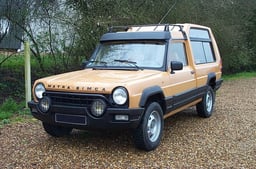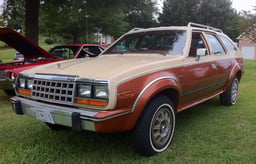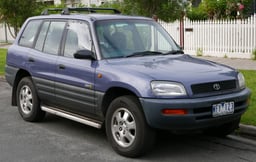Crossover (automobile)
-I67enJ0PPI0g0ztLrfdctjbP3FiKhu)
Crossover (automobile)
A crossover SUV— also called crossover or CUV— is a type of sports utility vehicle (SUV) with unibody construction.[1] Crossovers are often based on a platform shared with a passenger car; as a result they typically have better interior comfort, a more compliant ride, and superior fuel economy, but less off-road capability than truck-based SUVs.[2][3][4] The latter is compounded by many crossovers being sold without all-wheel drive, which challenges their definition as "sports utility vehicles".
Further, there are various inconsistencies about whether vehicles are considered crossovers or SUVs; therefore the term SUV is often used as a catch-all for both crossovers and compact SUVs.[5]
Forerunners of the crossover include the 1977 Matra Rancho and AMC Eagle introduced in 1979.[6]
In the United States as of 2006, more than 50% of the overall SUV market were crossover models. Crossovers have also become increasingly popular in Europe since the early 2010s.
Definition
The difference between crossovers and other SUVs is sometimes defined as a crossover being built using a unibody platform (the type used by most passenger cars), while an SUV is built using a body-on-frame platform (the type used by off-road vehicles and light trucks).[7][8][2][9] However, these definitions are often blurred in practice, since unibody vehicles are also often referred to as SUVs.[10][11] Also, crossover is a relatively recent term and early unibody SUVs (such as the 1984 Jeep Cherokee) are rarely called crossovers. Due to these inconsistencies, the term SUV is often used as a catch-all for both crossovers and SUVs.[12][3][13]
Outside of the United States, the term crossover tends to be used for C-segment (compact) or smaller vehicles, with large unibody vehicles— such as the Audi Q7, BMW X7 and Volkswagen Touareg— are usually called SUVs rather than crossovers. In the United Kingdom, a crossover is sometimes defined as a hatchback model with raised ride height and SUV-like styling features.[14][15]
Size categories
Subcompact crossover
Compact crossover
Compact crossovers are usually based on the platform of a compact (also known as C-segment) passenger car. The first compact crossovers included the 1994 Toyota RAV4,[19] 1995 Honda CR-V, 2000 Nissan X-Trail, 2000 Mazda Tribute and 2001 Ford Escape.
The number of compact crossover models offered has rapidly increased since 2010, and in 2019 it was stated that "so many of these vehicles are crowding the marketplace, simply sorting through them can be a daunting task".[20]
History
Introduced in 1979, the AMC Eagle is retroactively considered by some to be the first dedicated crossover,[21][22] which made its debut prior to the terms SUV or crossover being coined.[23][24] The mass-market Eagle model line was based on a unibody passenger car platform, with fully automatic four-wheel drive and a raised ride-height.[25][26][27][28][29] Others cite the 1977 Matra Rancho is a slightly earlier forerunner to the modern crossover.[30] Though it is not part of the modern linear evolution, and only fifteen were built, some stretch the definition and history of the "crossover" to regard the off-road racing 1936 Opel Geländesportwagen as the first of the class.[31]
The 1994 Toyota RAV4 is often cited as the model which fueled the crossover explosion.[19] The RAV4 was based on the platform of the Toyota Corolla hatchback and remains in production to this day.[4]
Europe
United States
Sales of crossovers increased 30% between 2003 and 2005.[3] By 2006, the segment came into strong visibility in the U.S., when crossover sales "made up more than 50% of the overall SUV market".[34] Sales increased in 2007 by 16%.[35] For Audi, the Audi Q5 has become their second best-selling vehicle in the United States market after the Audi A4 sedan.[36] Around half of Lexus' sales volume come from its SUVs since the late 1990s,[37] the majority of which is the Lexus RX crossover.
American manufacturers were slow to switch from their emphasis on light truck-based SUVs, and foreign automakers developed crossovers targeting the U.S. market, as an alternative to station wagons that are unpopular there. But by the 2010 model year, American car manufacturers had caught up.[3]
See also
Car classification
Compact SUV
List of SUVs
Mini SUV
Minivan
Recreational vehicle


